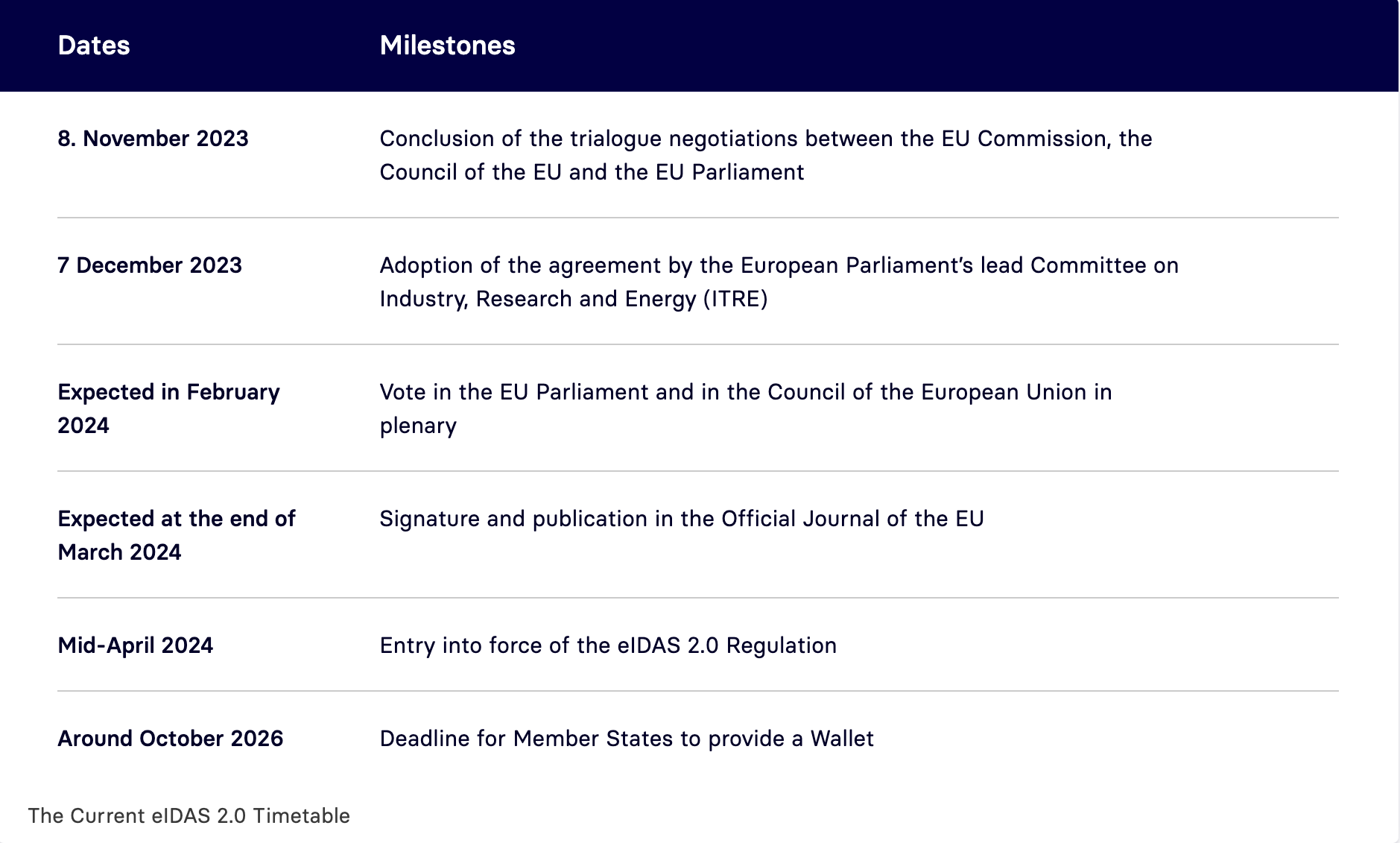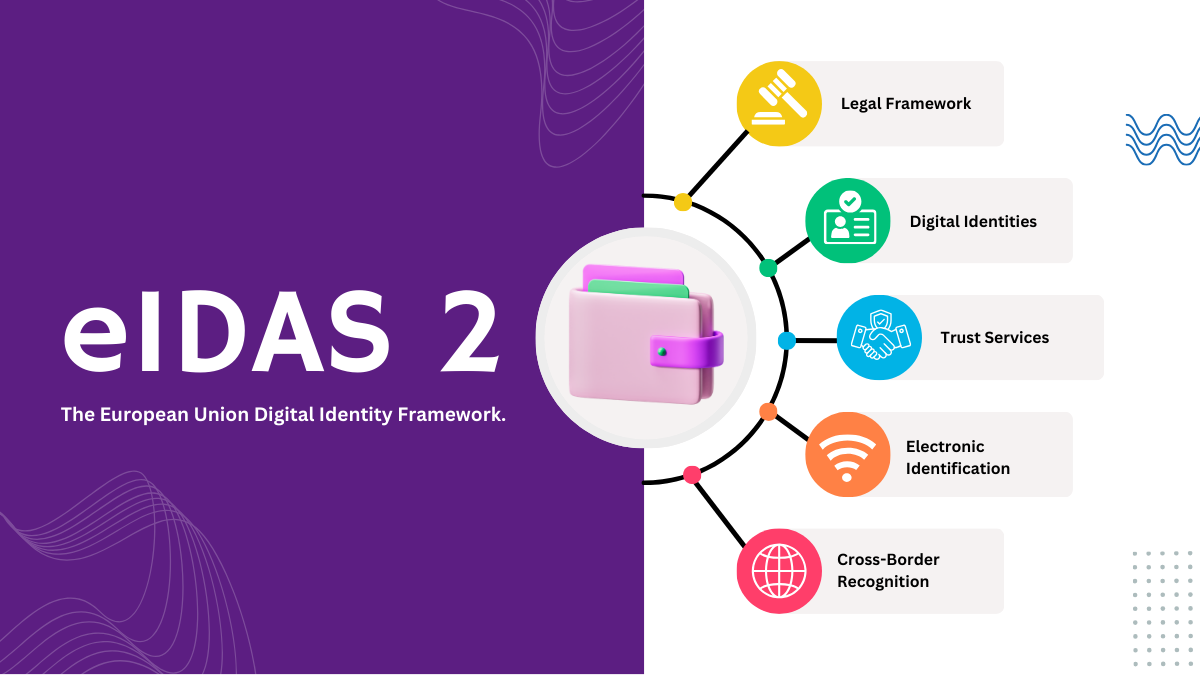TL;DR, eIDAS 2, or the European Digital Identity Framework, is an advancement over the original eIDAS regulation from 2014, aimed at enhancing digital transactions and identity verification across the EU. It introduces European Digital Identity Wallets (EUDI-Wallets) for secure management of digital identities, ensuring cross-border recognition and operability. Enhanced trust services and Qualified Electronic Attestation of Attributes (QEAA) are also part of eIDAS 2, aiming to improve online security, privacy, and convenience for EU citizens. The framework mandates member states to deploy digital ID wallets by October 2026. Hypersign contributes to this digital shift by developing infrastructure for Self-Sovereign Identity (SSI), promoting control over personal data, and offering solutions for digital identity and access rights management.
eIDAS, which stands for Electronic Identification, Authentication, and Trust Services, is an EU regulation designed to ensure that electronic interactions between businesses, citizens, and public authorities are secure, trustworthy, and easy to use. The initial version, known as eIDAS, came into effect in 2014 and set out a range of standards for electronic identification and trust services, including electronic signatures, seals, time stamps, delivery services, and website authentication.
Introduction to eIDAS 2 and Comparison with eIDAS
eIDAS was established in 2014, providing the first legal framework for secure and trusted digital transactions across the EU. This regulation focused on standardizing electronic identification and trust services, including digital signatures and online transactions, ensuring they are recognized across all EU member states.
eIDAS 2.0, known officially as the European Digital Identity Framework, was introduced to expand and improve upon the foundation laid by the original eIDAS. The new framework was agreed upon in a "trialogue" between the European Commission, the EU Parliament, and the Council of the European Union on November 8, 2023. The main goals are to address the original's shortcomings, enhance cross-border e-IDs, and deepen the European area of trust without undermining member states' sovereignty. The key project under eIDAS 2.0 includes providing EU citizens and legal entities with eID Wallets and ensuring their recognition across the EU.
The Current eIDAS 2.0 Timetable

Features of eIDAS 2
- European Digital Identity Wallets (EUDI-Wallets): A secure and standardized way for EU citizens to store and manage their digital identities and credentials directly on their smartphones, facilitating online authentication for private and administrative services across the EU.
- Cross-border Recognition and Interoperability: Ensures that digital identities and credentials are recognized and operable across all EU member states.
- Enhanced Trust Services: Introduces new services like electronic archiving and remote signature management, alongside improved regulations for existing trust services to enhance online security and trust.
- Qualified Electronic Attestation of Attributes (QEAA): This allows for the verification and validation of specific personal attributes, such as educational qualifications or professional licenses, improving the utility and scope of digital identities.
For EU citizens, eIDAS 2.0 means:
- More seamless and secure cross-border transactions and interactions.
- Enhanced privacy and control over personal data through the EUDI-Wallet.
- Greater convenience and efficiency in accessing and using public and private digital services across the EU.
- An increased range of services available digitally, reducing the need for physical documentation and in-person verification.
What is EUDI Wallet
The European Digital Identity Wallet (EUDI Wallet) is a digital tool proposed under eIDAS 2, aimed at enabling EU citizens to securely store and manage their digital identities and credentials, facilitating seamless access to a wide range of services across the European Union.
The EU Commission has unveiled the first EU Toolbox for the EUDI Wallet as part of eIDAS 2, which has been co-developed with Member States since February 10, 2023. This initiative is set to fortify the EU's digital identification framework, ensuring a higher trust level in digital transactions. The Commission is promoting pilot programs in vital sectors such as eHealth and mobile driving licenses, aiming for EU member states to deploy the wallet within a year. Key mandates include each state endorsing at least one type of electronic Digital ID Wallet, which could be government or privately issued but must remain free for all citizens. The wallet is expected to verify diverse attributes and be accepted by public and gradually by private services, enhancing the EU's digital infrastructure.
Road Ahead for eIDAS 2
The implementation of eIDAS 2.0 involves a complex schedule set to unfold over the next few years. The regulation is expected to be officially adopted and enter into force around mid-April 2024, following its signature and publication in the Official Journal of the EU. However, member states will have until around October 2026 to provide the necessary Wallet to their citizens. The European Commission will issue regulations for technical implementation within six to twelve months after the regulation's enforcement, with member states then having two years to comply.
As eIDAS 2.0 unfolds, its impact on digital identification and the overall digital landscape in the EU will be significant, promoting a more integrated, secure, and user-friendly digital environment.
How can Hypersign Help
At Hypersign, we have already developed a comprehensive infrastructure stack for Self-Sovereign Identity, recognized by the World Wide Web Consortium. We understand the intricacies of eIDAS and Identity Wallets and are well-positioned to partner with clients across Europe seeking development support. Reach out to us today at meet.hypersign@gmail.com.
About Hypersign
Hypersign is a cutting-edge, permissionless protocol designed to revolutionize digital identity and access rights management. By embracing the principles of Self-Sovereign Identity (SSI), Hypersign aims to empower individuals by allowing them to have full control over their own data and access on the internet. This platform offers a scalable, interoperable, and secure Verifiable Data Registry (VDR), which facilitates various applications rooted in SSI principles. Developed on the Cosmos-SDK, the Hypersign Identity Network has gained recognition from the World Wide Web Consortium (W3C), ensuring a robust, seamless, and secure management of Verifiable Credentials and Decentralized Identifiers. By providing solutions such as on-chain Know Your Customer (KYC) and Proof-of-Personhood, Hypersign stands at the forefront of digital identity, offering a more privacy-centric and user-controlled approach.



















